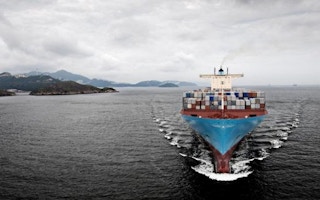Shipping industry leaders took a bold step towards greening the industry with the launch of a work plan on Thursday in Singapore for reducing the sector’s negative environmental impacts.
The 16 industry members of the Sustainable Shipping Initiative (SSI), a project coordinated by non-profit organisations Forum for the Future and WWF International, have given themselves one and a half years to reach four specific targets that will guide the industry toward environmental and financial sustainability by 2040.
Working groups will present their findings by September next year based on these targets, which include better methods for building and disposing of ships, financing models that promote sustainable shipping, facilitating the uptake of new, low energy technologies and implementing credible rating systems for good shipping practices.
SSI members include ship builders, owner and operators such as South Korea’s Daewoo Shipbuilding & Marine Engineering, Denmark’s Maersk Line, and the UK-registered China Navigation Company as well as financing and insurance firms such as Dutch bank ABN Amro, London-based marine insurer RSA and global consumer goods company Unilever.
China Navigation Company CSR manager Simon Bennett, who is part of the working group tasked with creating a model for the sustainable building and disposal of ships, told Eco-Business that when the auto industry undertook a similar initiative two decades ago because of increasing regulations, they found that companies benefited from more efficient use of resources and reduced waste.
The SSI model will be based on the concept of closed-loop manufacturing, which minimises industrial impacts on natural resources by recovering and reusing materials from products that are no longer used.
“Shipping needs to do this without being told and without waiting for the regulations,” he said, adding that China Navigation, Maersk and Carnival Cruise Lines are already working with suppliers on the issue in an effort to prove the concept.
He said that Chinese ship recycling facilities, or ship-breaking yards, are already beginning to see the business case for environmentally responsible management.
Between 90 to 95 per cent of the material from ship disposal is steel of varying grades that is recycled by shipyards. The rest of the material is complicated to separate and recycle, and it also contains hazardous materials such as asbestos that many shipyards, particularly in Asia, are ill-equipped to handle.
Chinese shipyards that have achieved better disposal methods are gaining a competitive advantage over their counterparts in South and Southeast Asia, noted Mr Bennett.
A European Union report which rated shipyards globally on disposal methods found that China’s shipyards scored well, whereas some shipyards in South Asia averaged a death per week and experienced daily injuries.
Last month, the European Commission tabled new regulations that would prevent the recycling of ships from its member countries in substandard shipyards where unsafe practices were endangering the local environment and the lives of workers.
The Commission estimates that globally shipyards dismantle over 1000 large commercial vessels each year. In 2009, over 90 per cent of the European ships sent for recycling went to emerging countries, with the majority going to South Asia.
To reduce the environmental and social impacts of European ships, which represent 17 per cent of the world’s vessels by capacity, the Commission proposed the regulations in the absence of an international agreement on ship disposal.
In 2009, members of the International Maritime Organization (IMO) drafted the Hong Kong International Convention for the Safe and Environmentally Sound Recycling of Ships, but the agreement has not yet garnered enough international support for implementation.
The European Commission regulations would require member states to ratify the Hong Kong Convention in addition to adopting a ship certification scheme that ensures responsible ship construction, operation and disposal.
With multiple regulations on the horizon, Mr Bennett said that his firm was one of several companies had decided that it was good for business to choose the Chinese shipyards despite a slightly higher cost. As a result, the motivation for China’s shipyards to promote sustainability has been monetized, he added.
There is also money to be made from the materials that are currently wasted, he noted.
The industry estimates that shipyards can recover an additional 10 per cent in the value of scrap materials through improved disposal methods.
Another working group will be trying to motivate the industry to adopt low energy technologies.
Mr Bennett said that such technologies are available but their suppliers say no one in the industry wants to take the lead in evaluating and testing them, which is a necessary step to their commercialisation.
Examples of low energy shipping technologies include ships fitted with sails and systems that improve fuel efficiency by coating the ship’s hull with air bubbles.
The SSI members, who announced their action plan at Fort Canning Park as part of Singapore Maritime Week, have committed to taking the lead on adopting cleaner technologies. “It is not a group that is going to sit and wait (for others to prove new technology),” said Mr Bennett.
Wärtsilä development team head Peter Jantzen said that the shipping industry is conservative in adopting new technology, but it is now ‘ripe’ for change.
Mr Jantzen is part of a working group to develop and pilot a new financing scheme for the implementation of new technologies. The group members include ABN AMRO, Cargill, Wärtsilä and RSA.
To address the need for financial incentives to switch to new technologies, the working group plans to work with the financial community to find ways of sharing the benefits and risks of financing such technologies, said Mr Jantzen, who noted that one possibility is a sustainable technology fund which subsidises technological improvements.
He added that the industry has reached a point when it is “our turn” to prepare for fuel savings and regulations.
It makes sense from a commercial view as well, said Mr Jantzen.
“The industry is facing financial hard times and we have to find savings.”










